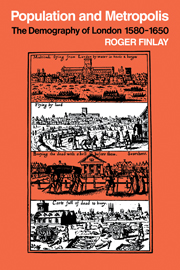Book contents
- Frontmatter
- Contents
- List of tables
- List of figures
- Preface
- 1 Introduction: The magnet of the metropolis
- 2 The accuracy of the London parish registers
- 3 The general growth of population in London
- 4 London social structure in 1638
- 5 The measurement of mortality rates
- 6 The effect of plague on mortality experience
- 7 Marriage and fertility
- 8 Population and metropolis
- Appendix 1 The London bills of mortality
- Appendix 2 Baptisms and burials in sample London parishes
- Appendix 3 Details from the 1638 listing and administrative divisions of London
- Appendix 4 London population in 1631 and houses in 1638 by wards
- References
- Index
5 - The measurement of mortality rates
Published online by Cambridge University Press: 06 July 2010
- Frontmatter
- Contents
- List of tables
- List of figures
- Preface
- 1 Introduction: The magnet of the metropolis
- 2 The accuracy of the London parish registers
- 3 The general growth of population in London
- 4 London social structure in 1638
- 5 The measurement of mortality rates
- 6 The effect of plague on mortality experience
- 7 Marriage and fertility
- 8 Population and metropolis
- Appendix 1 The London bills of mortality
- Appendix 2 Baptisms and burials in sample London parishes
- Appendix 3 Details from the 1638 listing and administrative divisions of London
- Appendix 4 London population in 1631 and houses in 1638 by wards
- References
- Index
Summary
It is well known that mortality rates were invariably high in the preindustrial city, but little attention has been concentrated on assessing how high these rates actually were. In this chapter it will be shown how life tables may be calculated for children of London parishes in the period before the establishment of civil registration in 1653, by the method of partial family reconstitution outlined in Chapter 2. This technique has the advantage over the reconstructions pioneered by M. F. and T. H. Hollingsworth because it may be applied to all those parishes with registers that are sufficiently complete for the normal process of family reconstitution, and not simply to those three parishes for which ages at death are given in the burial registers (St Peter Cornhill from 1579 to 1604, Allhallows London Wall between 1578 and 1598, and throughout the period from 1600 in St Botolph Bishopsgate). The subject of this chapter will be the normal background level of mortality which prevailed. In the next chapter, attention will be turned to the impact of the plague crises. Because of the unusual age-incidence of plague mortality, where the victims were more likely to be children than adults, the tables presented here eliminate plague deaths in order to obtain estimates of the normal levels of mortality in London.
It is difficult to measure short-term fluctuations in mortality rates within a period of less than about fifty years by family reconstitution methods – a further reason why epidemic plague mortality requires separate treatment.
- Type
- Chapter
- Information
- Population and MetropolisThe Demography of London 1580–1650, pp. 83 - 110Publisher: Cambridge University PressPrint publication year: 1981

